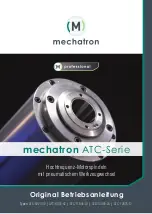
Page
8
of
12
Assembly
Clean components with mineral spirits or similar solvent.
Inspect for wear/damage and replace as necessary.
Replace all seals of disassembled components using
Service Parts Kit, P/N 256KIT. Smear LUBRIPLATE 130AA
or PARKER-O-LUBE on rings and mating parts to ease
assembly. Carefully assemble tool without damaging O-
rings, Quad rings, or Back-up rings.
1. (Figure 4) Install O-ring inside handle; then push sleeve
in handle until it bottoms on the chamfer.
2. Holding handle inverted in a vice, install timing pin;
then place air cylinder on handle with timing pin
positioned in matching hole. Assemble Main Gland
Assembly. Apply anti-seize compound (p/n 508183) to
gland threads. With a 1-3/8 inch socket wrench, torque
it into the handle to 75-85 foot lbs.
3. Push air piston assembly and piston rod into air
cylinder until it seated inside of air cylinder (Figure 3).
4. Turn tool upright. Assemble Intensifier Piston with
O-Ring and Back-up Rings; then apply Loctite 243 to
intensifier piston screw threads, and carefully press in
from top of handle.
5. Holding Self-locking Nut with 9/16 socket and
extension, screw intensifier piston onto piston rod
using 7/64 hex key, and torque to 180-190 in. lbs.
6. Hold handle in vise with bottom up. Push Cylinder
Head Assembly squarely into air cylinder. Install
Retaining Ring.
7. Position O-Ring and Muffler on center of air cylinder.
Place Bottom Exhaust Gasket on air cylinder. Place
Muffler End Cap on top of Gasket, and secure with 3
Cap Screws using 5/32 hex key.
8. Turn tool upright. (Figure 5) Drop Throttle Valve Spring
into Throttle Valve hole in cylinder. Push Throttle Valve,
with O-rings in place, into cylinder.
9. Assemble Trigger, Cable, and Cable Pin, and slide Cable
into Handle. Align hole in Trigger with hole in Handle
and install Trigger Pin with a hammer and punch.
10. Slide Throttle Arm onto ball end of throttle cable.
Swing arm until end fits over throttle valve. Attach
throttle arm Bushing and Screw to Throttle Arm.
Tighten with 5/32 hex key.
11. If air hose assembly was removed, reinstall it.
12. If Relief Valve Seat Assy is being replaced, push Plug
“A”, with seals in place, into head. Install Screw “B”.
(Figure 10)
13. Carefully drive Relief Valve Seat Assy in using a soft
drift, without damaging Relief Valve Ball surface.
14. Assemble Pull Piston with new seals. Lubricate with
LUBRIPLATE or PARKER SUPER-O-LUBE.
15. Thread Assembly Bullet onto Pull Piston Assy. (Figure 2)
NOTE: Spacer not needed during assembly. Its purpose
is to push out the front gland during disassembly.
16. Push Front Gland Assy, with all seals, Housing, and
Wiper in place, over Assembly Bullet and onto Pull
Piston. Push entire gland/piston assembly into Head.
17. (Figure 10) Install O-rings and Back-up Rings on Rear
Gland and push complete assembly into Head. Screw in
Cylinder Cap and tighten.
18. (Figure 10) Install O-ring & Back-up Ring on Relief
Valve Plug; then install Ball, Guide, Sleeve, Spring, and
assembled Relief Valve Plug into head.
19. Install O-
ring on Check Valve Plug “D”, then install
Ball, Guide, Spring, and assembled Check Valve Plug
into head.
20. Push Pintail Deflector onto barbed end of Pull Piston.
21. (Figure 10) Place O-
rings on Bleed Plugs “C” & “E” and
screw assemblies into Handle and Cylinder Head.
22. (Figure 10) Install all O-rings and Back-up Rings on Pull
and Return Glands. Push Gland Assemblies into handle.
Push Head down on glands.
23. Place tool in a vise, head down, and install 4 Cap
Screws, and proceed to Fill & Bleed section of this
manual.






























